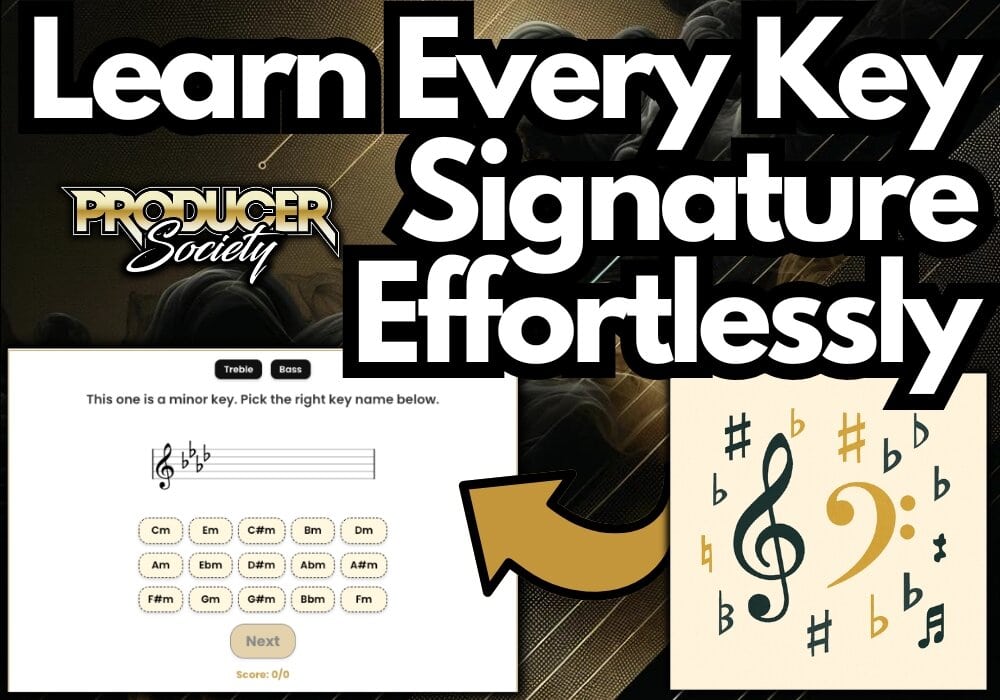Key Signature Quiz
What The Key Signature Memorization Tool Does
Hey what’s good, it’s good to see you again. I decided to make my own key signature quiz, which essentially functions as a memorization tool.
It’s really helpful if you want to do practice runs of all the keys. Personally, I think it’s probably best to play and read music than to do quizzes.
That said, it’s helpful for knowledge and fun to use if you’re outside having a smoke, waiting for your laundry to dry, or waiting for food to cook. Rather than doom-scrolling social media.
My Key Signature Quiz helps you master all 30 major and minor key signatures in both treble and bass clefs.
It randomly displays a key signature and asks you to choose its name from the grid of buttons. Track your score as you go, and switch clefs at any time.
How to Use the Key Signature Quiz
1) Select Clef
- Click Treble or Bass at the top to choose which clef you want to practice.
2) Read the Prompt
- The question text tells you whether it’s a “major” or “minor” key.
3) Identify the Signature
- Look at the staff: count and position the sharps or flats.
- Click the button that matches the key’s name (e.g. “D♭” or “Bm”).
4) Check Your Answer
- Correct answers turn green and play a confirmation sound; incorrect turn red.
- Click Next to move on.
5) Track Your Progress
- Your current score (right vs. total) shows at the bottom.
Quick Primer: What Is a Key Signature?
A key signature tells you which notes are consistently sharp ♯ or flat ♭ throughout a piece. It appears right after the clef sign on the staff.
- Major keys use a pattern of whole- and half-steps that ostensibly sound “bright.”
- Minor keys use a different pattern (natural/harmonic/melodic minors) that tend to sound “darker” or “sad,” but not always.
Order of Sharps & Flats
When you count accidentals, they always appear in the same order:
- Sharps (♯): F♯ → C♯ → G♯ → D♯ → A♯ → E♯ → B♯
- Mnemonic: “Father Charles Goes Down And Ends Battle”
- Flats (♭): B♭ → E♭ → A♭ → D♭ → G♭ → C♭ → F♭
- Mnemonic: “Battle Ends And Down Goes Charles’ Father”
To build a key signature:
- Sharps: Start with C major (no sharps), then add the next sharp in order for each new key (G has 1♯, D has 2♯, etc.).
- Flats: Start with C major, then add flats in reverse order for each new flat key (F has 1♭, B♭ has 2♭, etc.).
Memorization Tips

1) Circle of 5ths
Visualize keys around a clock—each step clockwise adds a sharp, each step counterclockwise adds a flat.
2) The Best Trick I Know
I use a couple of simple tricks for remembering the keys and I’ll share all of them now.
For Major Keys (♯)
In major (♯) keys, the key’s name is always the note a half‐step above the last sharp in its signature.
For example, B major’s sharps are F♯, C♯, G♯, D♯, and A♯—so the note immediately following the final sharp (A♯) is B, which gives the key its name.
For Major Keys (♭)
In flat‐key signatures, the key’s name is given by the previous flat. For example, E♭ major has B♭, E♭, and A♭ – the second-to-last flat is E♭, which is both the tonic and the name of the key.
For Both Minor Keys (♯and♭)
In case you don’t know, there is always a relative major or minor key. This means that there is a key signature of the opposite quality that shares the same accidentals.
For instance, the Key of A Major has 3 sharps: F, C, and G. This is the same number of sharps as F#m.
A major key’s relative minor is always the sixth scale degree (also called a note).
So in A major, whose sixth note is F♯, the relative minor is F♯ minor.

